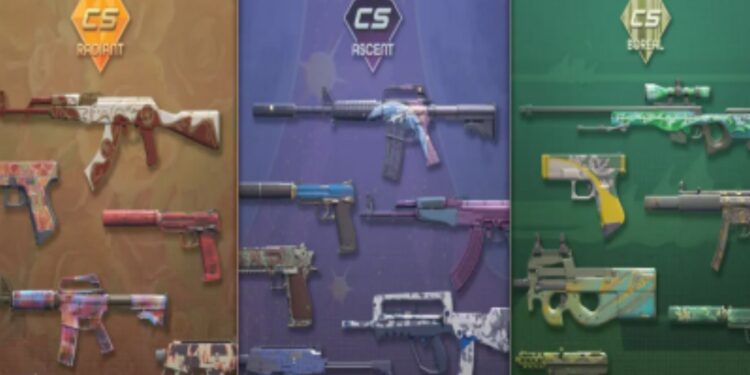The gaming industry is among the fastest growing. Today, the globalization of the market is tens or even hundreds of millions of dollars, and the economy of in-game items occupies an important part of this market. Skins, loot boxes and virtual merch have become the foundation of an ecosystem that affects both players and developers, as well as the global digital asset market. In this article we will tell you how the economy of in-game items works, the mechanisms that make it so profitable and why it is inextricably linked with the culture of modern gaming.
Skins as a Digital Economy Driver
Skins are one of the most important factors in the development of the gaming industry economy. Unlike in-game items, which primarily affect the gameplay, skins perform an aesthetic function. They change the appearance of characters, weapons or interface, allowing the player to customize the game for themselves.
Skins have become players’ self-expression as well as an investment tool. Rare items can grow in value, and trading on third-party marketplaces has become a separate business. Some rare skins in CS2 or Dota 2 cost thousands of dollars.
A feature of this market is its dependence on demand, prestige, and even tournament events. For example, the most expensive items in Dota 2 are in most cases for the most expensive heroes. By tracking special platforms such as dota live score, one can notice that with the growing popularity of certain heroes, the prices of items for them also change. Thus, skins have long ceased to be just a decorative element and have become part of the financial ecosystem, which, although it does not affect gameplay, allows customizing the gaming environment and standing out.
Loot Boxes: Chance, Psychology, and Profit
Loot boxes are another popular monetization tool. Their essence lies in the purchase of a “box” in which the player randomly receives game items. This approach adds excitement, because the player always hopes to get something rare or valuable.
For developers, loot boxes bring a huge profit and are an almost flawless business strategy. The cost of their creation is minimal, and the profits are multimillion. At the same time, this format has repeatedly become the subject of discussion among regulators, and even compared with gambling. In some countries, companies are forced to disclose the likelihood of certain items falling out in order to avoid legal problems.
From the player’s point of view, loot boxes are not so effective, because they are based on chance. Even if the chances of getting an expensive item are slim, thousands of users are still willing to spend money to try their luck instead of just buying it. The presence of loot boxes in most online video games has led to the formation of a kind of secondary market, where players resell mined items, often for real money.

Virtual Merch and Identity in Gaming
Virtual merch is a less popular monetization strategy than the ones mentioned above, but it is also effective. It is not only about T-shirts with a game or brand logo, but about unique digital items that allow the player to demonstrate their commitment to the game or team directly in the gaming environment. This works most effectively during esports events when players support their teams.
This includes unique banners, emblems, avatars and even in-game titles. For example, in Dota 2, players can team bundles in front of The International thereby expressing their support for the team. A percentage of those purchases go directly to the team. This not only enhances the sense of belonging, but also forms a long-term loyalty to the game.
Esports tournaments play an important role. Not only in Dota 2, but in most esports disciplines, teams sell their own real and digital merch, and sometimes part of the profit goes to finance prize funds. In simple words, players support their favorite teams, receiving unique items in return, and the organizers receive financial stability.
Risks, Regulations, and the Future of In-Game Economies
Despite impressive growth, the economy of in-game items has risks and faces certain challenges. For players, one can note the dependence on excitement, the risk of losing money in unstable markets and the lack of clear regulation rules. Although if the player is smart about buying game items, these risks become minimal.
The in-game asset market is still a gray area. Players can spend thousands of dollars on skins, but losing an account or platform ban automatically zeroes in on their investment. This creates a need for trading only on official platforms, as well as potential conflicts between users and companies.
Governments of different countries are paying more and more attention to this issue. Openness, protection of players’ rights and transparency of the chances of dropping items can gradually become a standard for most online video games. This greatly improves the trading conditions for players.
By overcoming risks, the market of in-game items will have enormous potential to rival other major economies. The development of the gaming industry is connected not only with profitability but also with cultural trends. When new games, skins, or items are released, new trends and new investments are created. Digital identity becomes as important as the real one, and virtual items turn into full-fledged economic assets.
Conclusion
The economy of in-game items is a full-fledged ecosystem that unites the interests of players, developers and investments. In this text, you learned how skins have created a unique digital culture and secondary market, and loot boxes bring developers billions in profits. Virtual merch has become a tool for self-expression, and for players to become part of the esports success of their favorite teams.
Despite the risks and challenges, this area continues to develop, and in the future the globalization of the gaming industry will only grow. Virtual subjects have already proved that they can be not only entertainment, but also a tool for investment, forming the economy of the industry.









